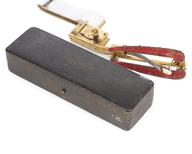





Transmission type Marey sphygmograph (with tambour) by Verdin, may have belonged to Marey, belonged to Lauder Brunton, French, 1860-1904
French physiologist Étienne-Jules Marey developed this sphygmograph. Marey improved the basic sphygmograph invented by German physiologist Karl Vierordt (1818-84) in 1855 by making it portable. It is thought this instrument may have belonged to Marey himself. A sphygmograph records the pulse. It is placed on the wrist. The movement of the pulse is transmitted through the rubber diaphragm. A lever attached to the diaphragm records the pulse contraction on smoked paper.
Details
- Category:
- Clinical Diagnosis
- Collection:
- Sir Henry Wellcome's Museum Collection
- Object Number:
- A600282
- Measurements:
-
overall: 50 mm x 115 mm x 70 mm, 0.13 kg
- type:
- sphygmograph
- credit:
- Brunton, L.




